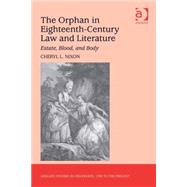The Orphan in Eighteenth-Century Law and Literature: Estate, Blood, and Body
, by Nixon,Cheryl L.- ISBN: 9780754664246 | 0754664244
- Cover: Hardcover
- Copyright: 5/28/2011
Cheryl Nixon's book is the first to connect the eighteenth-century fictional orphan to the eighteenth-century legal ward. Examining novels by authors such as Eliza Haywood, Tobias Smollett, Frances Burney, and Jane Austen, and referencing never-before analyzed manuscript case records, Nixon reconstructs the narratives of real orphans in the Court of Chancery and compares them to the narratives of fictional orphans. Emphasizing the eighteenth century's development of new novelistic subgenres, Nixon argues that the figure of the orphan reveals the formulaic gendering of forms such as the picaresque and romance and ultimately encourages a hybridization of these plots. In legal proceedings and in the novel, the orphan demands a replacement family that is both 'fictional,' to the extent that it is not biologically constructed, and 'factual,' that is, a legally regulated structure, making the orphan the perfect figure for connecting fictional and factual narratives of the family.Whereas other studies have focused on the destitute foundling and foundling hospital, Nixon focuses particularly on the constructed family, typically a guardian/ward relationship, whichsituates the orphaned heir or heiress in a domestic space. She shows how the eighteenth-century orphan became associated with Chancery and its property-centered definition of the child. New archival research encompassing Chancery, the Court of Wards, and the London Court of Orphans demonstrates that Chancery replaces the other court systems and only heard cases of orphans with property. Emphasizing class-based understandings of the child, Nixon argues that the wealthy orphan is central to the development of domestic fiction. As Nixon traces the orphan's contribution to the developing novel and developing ideology of the family, she shows how the orphan's movement from one replacement family structure to another reveals the family itself to be an adventure.







